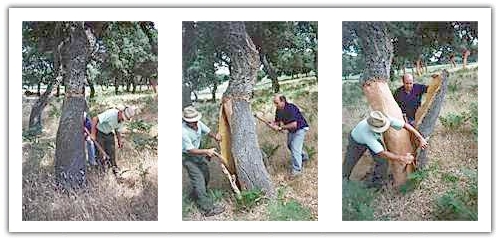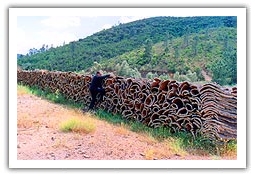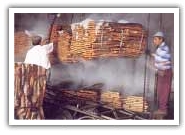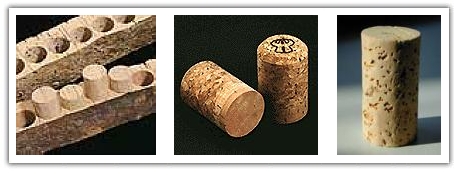Cork

Sources and harvesting
Cork material is a prime-subset of generic cork tissue, harvested for commercial use primarily from the Cork Oak tree,
Quercus suber, with Portugal producing 50% of cork worldwide. Cork consists mostly of suberin.
There are about 2,200,000 hectares of cork forest worldwide; 33% in Portugal, and 23% in Spain.
Annual production is about 340,000 Tons; 52% from Portugal, 32% from Spain, 6% Italy.
Once the trees are about 25 years old the cork is stripped from the trunks every 9 years.
The trees live for about 200 years. The first 2 harvests produce poorer quality cork.
The cork industry is generally regarded as environmentally friendly. The sustainability of production and the easy recycling
of cork products and by-products are two of its most distinctive aspects. However, only two cork companies, Oeneo Bouchage
of France, and the Cork Supply Group of Portugal, have conducted and released their complete carbon footprint studies.
Since cork oak forests now comprise the majority of habitat for the Iberian lynx, one of the most endangered cat species in
the world, the lynx's survival is believed to depend upon the continued viability of cork production.



Properties and uses
Cork's elasticity combined with its near-impermeability makes it suitable as a material for bottle stoppers, especially
for wine bottles. Cork stoppers represent about 60% of all cork based production.
Cork's low density makes it a suitable material for fishing floats and buoys, as well as handles for fishing rods (as an
alternative to neoprene).
Sheets of cork, often the by-product of more lucrative stopper production, are used to make floor tiles and bulletin boards.
Granules of cork can also be mixed into concrete. The composites made by mixing cork granules and cement have low thermal
conductivity, low density and good energy absorption. Some of the property ranges of the composites are density (400–1500 kg/m³),
compressive strength (1–26 MPa) and flexural strength (0.5–4.0 MPa).
Use for wine bottle closures
As late as the mid 1600s, French vintners did not use cork stoppers, using oil-soaked rags stuffed into the necks of bottles instead.
Natural cork closures are used for about 80% of the 20 billion bottles of wine produced each year. After a decline in use as
wine-stoppers due to the increase in the use of cheaper synthetic alternatives, cork wine-stoppers are making a comeback and currently
represent approximately 60% of wine-stoppers today.
Cork is an ideal material for use as a bottle stoppers. Because of the cellular structure of cork, it is easily compressed upon
insertion into a bottle and will expand to form a tight seal. The interior diameter of the neck of glass bottles tends to be
inconsistent, making this ability to contract and expand to seal, an important attribute.
Since the mid-1990's, a number of wine brands have switched to alternative wine closures such as synthetic plastic stoppers,
screwcaps, or other closures. Screwcaps are often seen as a cheap alternative destined only for the low grade wines. These
alternatives to real cork have their own properties, some adventageous and others controversial. For example, while screwtops
are generally considered to offer a TCA trichloroanisole free seal they reduce the oxygen transfer rate to almost zero, which
can lead to reductive qualities in the wine. TCA is one of the primary causes of cork taint in wine. However, in recent years
major cork producers (Amorim, Álvaro Coelho & Irmãos, Cork Supply Group and Oeneo) have developed methods that remove most, but
not all TCA from natural wine corks. Natural cork stoppers are important because they allow oxygen to interact with wine for
proper aging, and are best suited for bold red wines purchased with the intent to age.
A study made public in December 2008 by PricewaterhouseCoopers, commissioned by cork manufacturer Amorim, concluded that cork
is the most environmentally responsible stopper, in a one-year life cycle analysis comparison with the plastic stoppers and aluminium screwcaps.

Other uses
Cork is used in musical instruments, particularly woodwind instruments, where it is used to fasten together segments of the instrument, making the seams airtight. Conducting baton handles are also often made out of cork.
Cork can be used as bricks for the outer walls of houses, as in Portugal's pavilion at Expo 2000.
On November 28, 2007, the Portuguese national postal service CTT issued the world's first postage stamp made of cork.
Cork has been used in rocket technology due to its fire resistance.
Cork is used as the core of a baseball.



 Regions of France
Regions of France Regions of Spain
Regions of Spain Regions and areas from the world
Regions and areas from the world